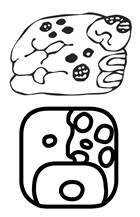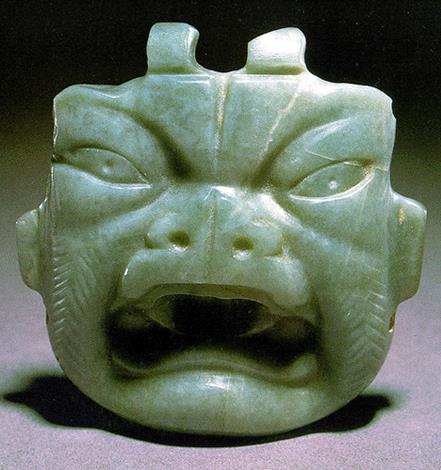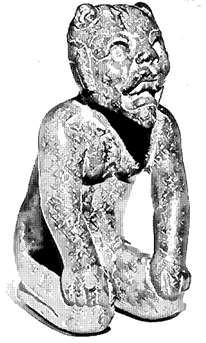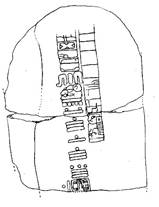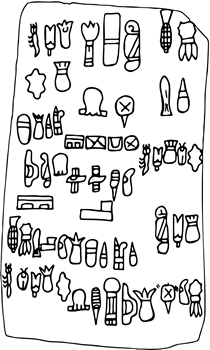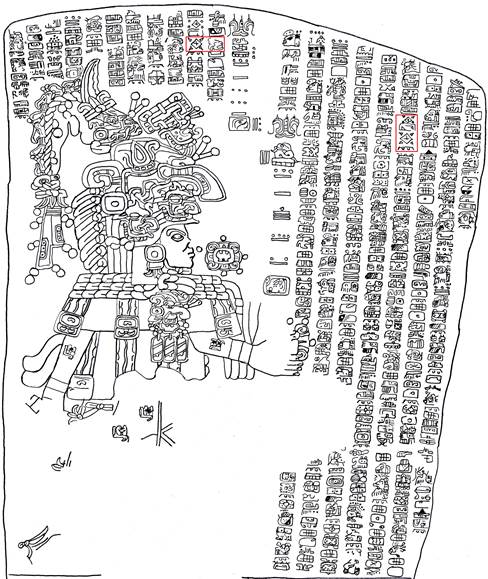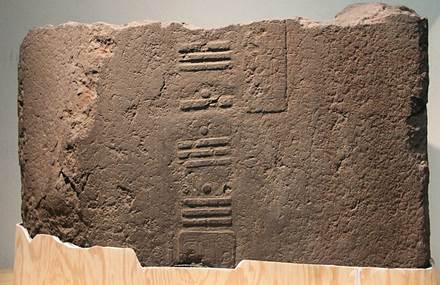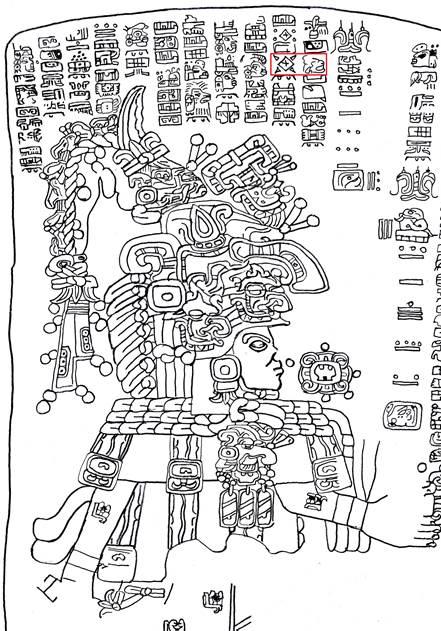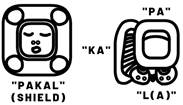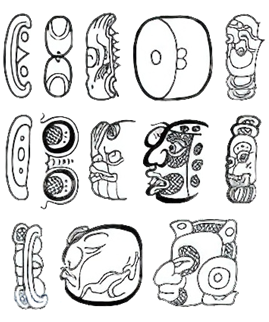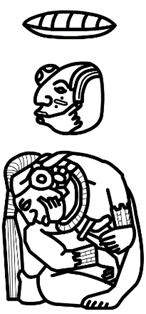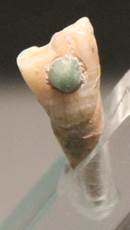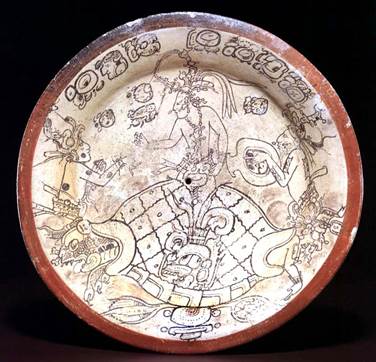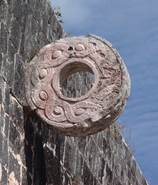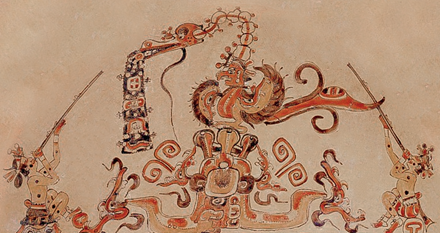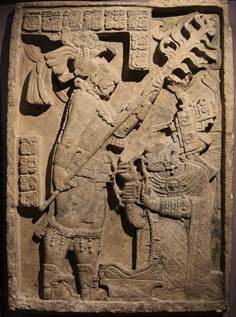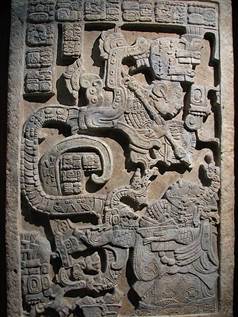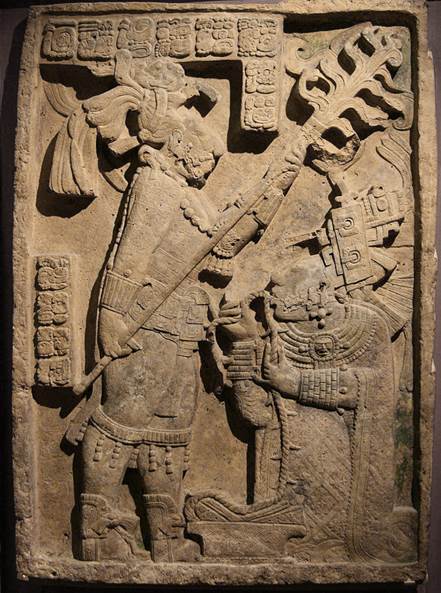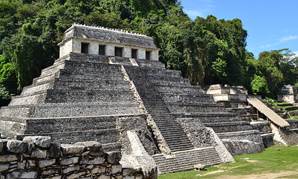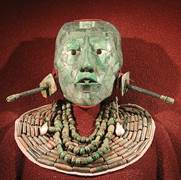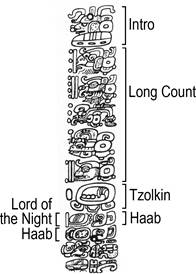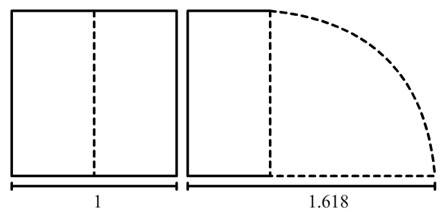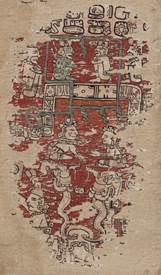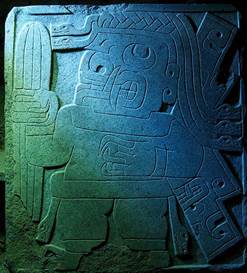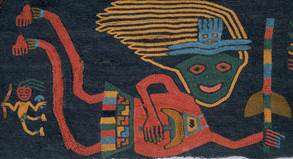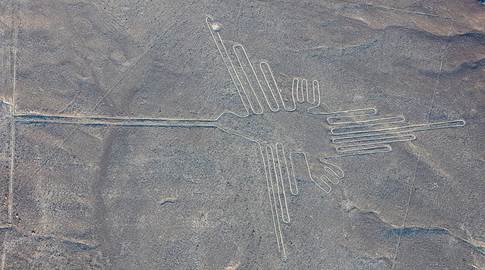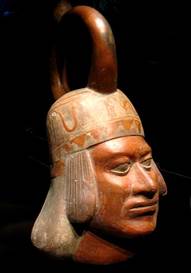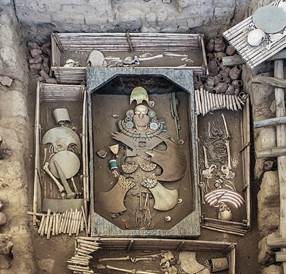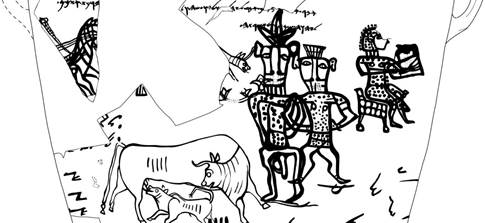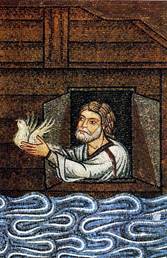While the civilizations on the Eurasian continent regularly exchanged inventions, those in Meso- and South America developed in complete isolation. This makes it an interesting case study to figure out what are universal aspects of civilization. The similarities are stunning. The Americas also developed agriculture, irrigation canals, aqueducts, cities, palaces, temples, tombs, and pyramids. They also had farmers, artisans, poets, scribes, mathematicians, astronomers, soldiers, merchants, bureaucrats, physicians, priests, royalty, and sacrificial victims. There are also things absent in Meso- and South American civilization. For instance, they never invented the wheel, did not reach the Iron Age, and there was a greater emphasis on the use of hallucinogens to contact the spirit world.
Early America
The early days of America are still shrouded in mystery. Until recently, scholars assumed that hunter-gatherers first entered the Americas around 13,000 BC via the Bering Strait, which during the last ice age formed a land bridge between Russia and North America due to lower sea levels. In recent years, however, evidence of human settlement predating this period has come to light. The best documented site is called Monte Verde, in Chile, and dates to about 16,500 BC. Since ice sheets covered much of North America at the time, these people must have traveled along the coastline. Other sites give even earlier dates for the arrival of humans in America, but these are less well verified. Agriculture in the Americas dates back to about 5000 BC and was based around maize, beans, squash, chili peppers, avocados, pumpkins, and also cotton.
The Olmecs
The earliest civilization in Mesoamerica is called the Olmec Civilization, which started around 1700 BC. Its existence was first discovered in 1850, when a sculpture known as a colossal head was found (see Fig. 139). These heads weigh tons, are up to 3.4 meters in height, and the faces of these sculptures show remarkably realistic features.
At the important early site called San Lorenzo (1700-1000 BC), the Olmec built the Red Palace, of which only the ruins remain today. Part of the construction were four-meter-tall basalt columns, which were brought in from a distance of 60 kilometers. The palace also had a basalt aqueduct that was at least 170 meters in length. The later site called La Venta (1000-400 BC) contains a 34-meter-tall earthen-mound pyramid, which used to have stairs on each side.
Fig. 139 – A 2.5-meter-tall colossal head known as the La Venta Monument 1 (c. 8th century BC) (Glysiak, CC SA-BY 4.0; Villahermosa, Mexico)
Fig. 140 – A figure crawling from a cave, holding a were-jaguar baby. La Venta Altar 5 (1000-400 BC) (Ruben Charles, CC 2.0; Villahermosa, Mexico)
Fig. 141 – A jade were-jaguar from Costa Rica (Justin Kerr)
The Olmecs also created stone altars (although they might in fact be thrones). Some are decorated with sculptures of figures crawling from caves, perhaps signifying the underworld. The person emerging from Altar 5 (see Fig. 140) is holding what seems to be a partly transformed baby. Since some of these transformed figures have fangs and claws, they have been called were-jaguars (see Fig. 141, Fig. 142 and, Fig. 143). It has been hypothesized by some scholars that these human-jaguar hybrids represent shamans in the process of transforming into an animal. In the first chapter, we demonstrated that this is a worldwide motif among tribal cultures. We see similar transformed figures in many cultures in both Meso- and South America (see for example Fig. 142 from South America). The connection between the jaguar and shamanism is made explicit in various native American languages. For instance, in the South American language Guarani, the word for shaman, “yagua-ava,” literally means “men in their jaguar selves.” Another example is the Mayan phrase “chilam balam” meaning “shaman-jaguar.” An associated Mayan word is “way,” which means something like “spirit animal counterpart.” The glyph for this word is a face half covered by a jaguar pelt (see Fig. 144). It refers to the ability of so-called naguals to shapeshift into their animal counterpart.
Fig. 142 – Half-feline, half-human head from the Cupisnique culture of Peru (900-200 BC) (Rowanwindwhistler, CC BY-SA 4.0; Museo Larco–Lima, Peru)
Fig. 143 – A kneeling were-jaguar from the Olmec civilization (900-300 BC) (Own work; Dumbarton Oaks, United States)
Fig. 144 – On top: The Maya glyph “balam” (Goran tek-en; CC BY-SA 4.0) Below: The Maya glyph “way” (S. P. Dinkgreve, worldhistorybook.com)
The Olmec script
The earliest script of the Americas also belonged to the Olmec and dates to before 900 BC, as evidenced by one object known as the Cascajal Block (see Fig. 145). The next example of writing comes from about 300 years later, from the Zapotec Civilization, showing a captive next to a glyph that reads “1 earthquake” (see Fig. 146). This is a day-name from the 260-day calendar that was used across Mesoamerica (and which we will discuss later).
Fig. 145 – The Cascajal Block from the Olmec civilization showing the first evidence of a script in the Americas (c. 900 BC) (John C, CC BY 3.0)
Fig. 146 – Zapotec monument 3 at San Jose Mogote, Mexico, showing the day-name glyph “1 earthquake” (c. 600 BC) (Siyajkak)
Fig. 147 – Stela C at Tres Zapotes showing a Long Count date (7.16.6.16.18 = 32 BC)
Fig. 148 – The lower part of Stela C. The upper half was found later and is located in a museum at Tres Zapotes (Gary Todd, CC0 1; the National Museum of Anthropology, Mexico City)
The first readable date, corresponding to 32 BC, comes from the late Olmec site Tres Zapotes (300 BC-300 AD) (see Fig. 147 and Fig. 148).
Much more impressive is the La Mojarra Stela (c. 150 AD), which contains the first large text (see Fig. 149). It also contains the earliest solid textual reference to astronomy in the Americas, showing a glyph representing a solar eclipse (an open mouth devouring the sun) and referring to the appearance of Venus.
Fig. 149 – La Mojarra Stela from the Olmec civilization containing the oldest known large text from the Americas (c. 150 BC). The solar eclipse glyphs are boxed (PauloCalvo, CC BY-SA 4.0)
The Mayan script
The most famous writing system of the Americas is the Mayan script (the earliest examples dating from the 3rd century BC), which was deciphered with great difficulty in the 1970s by various scholars. What made the decipherment especially difficult was that every glyph exists in many variations. Writing was seen as an artform and writers were allowed to change the glyphs according to their own artistic taste (the Mayan word for “painter” was the same as their word for “writer”). In Fig. 151, for instance, we see the many ways to write the letter “u.” Fig. 152 shows three ways to write “zero,” which could be written as an abstract shell, a head, or an entire being. The result is a beautiful script, but not the most practical one.
The deciding moment of the decipherment happened when glyphs were studied related to a Mayan ruler at the city of Palenque. Sometimes, his name was written with the symbol of a shield, which in modern Mayan reads “pakal.” In other cases, his name was written as a more complex glyph consisting of three syllables, which had earlier been identified as “pa,” “ka,” and “la.” With the last vowel always being silent, it too became “pakal” (see Fig. 153). [41]
Fig. 150 – Chocolate vessel from Rio Azul (c. 500 AD) (own work; The National Museum of Archaeology and Ethnology, Guatemala)
Fig. 151 – Various ways to write the letter “u” in the Mayan language (Breaking the Maya Code, Michael D. Coe, 1992).
Fig. 152 – Various ways to write the number “0” in the Mayan language (S. P. Dinkgreve, worldhistorybook.com, after Writing Systems, Henry Rogers, 2005).
Fig. 153 – Two ways to write “pakal” in the Mayan script (S. P. Dinkgreve, worldhistorybook.com)
In Fig. 150, we see another example of a Mayan glyph, written on a cacao vessel. Mayan elites drank a chocolate drink from these vessels mixed with chilies. The glyph depicted in the figure reads “ka-ka-w(a),” which became our word “cacao.”
Around 300 AD, the Mayans also invented paper, made from tree bark, which they beat with stones into long sheets of up to ten meters long. The paper was then painted on both sides and folded together like an accordion. When the Spanish arrived, there were thousands of books on all sorts of topics, but most were tragically burned. Today, there are only four pre-Columbian Mayan books left. The destruction of these books was in large part due to a Franciscan friar named Diego de Landa (1524–1579), who was shocked by Mayan religion, especially by their tradition of human sacrifice, and wanted to eradicate it. To learn about his “opponents,” he studied their language and culture. When convinced of a Maya underground resistance, he burned books, ritual objects, and even people. About the burning of books we read:
We found a large number of books in these characters and, as they contained nothing in which there were not to be seen superstition and lies of the devil, we burned them all, which [the Mayans] regretted to an amazing degree, and which caused them much affliction. [42]
Since even the Spaniards found his behavior cruel, he was sent back to Spain where he spent five years in jail. Here, he wrote An Account of Things of Yucatan, which is, paradoxically, one of the most significant Maya ethnographies ever written. In this work, he recorded all aspects of Maya life, from food to religion to calendar rituals. He also added a description of Maya hieroglyphs, which would help the decipherment effort in the 20th century. Landa used his book in his defense to argue in favor of forced conversion. He finally won his case and was sent back to Mexico, where he became bishop of Yucatan.
The Maya and the Popol Vuh
The Mayan Civilization is in many ways the most impressive of the pre-Columbian cultures of the Americas, known for their world-class architecture, writing, art, calendar making, and astronomy. The first Maya cities developed around 750 BC, began to possess monumental architecture around 500 BC, and peaked between 250 and 650 AD. Among the early Maya cities was Kaminaljuyu, which today lies underneath Guatemala City. At this site, we have found the remains of many temples and pyramids, beautiful stelae, long inscriptions, and even two aqueducts more than a kilometer long. The largest Maya city was El Mirador, which peaked between 300 BC and 100 AD and had a population of perhaps 100,000 people. The city, which today is mostly in ruins and swallowed up by the jungle, included thousands of stone buildings, including two pyramids, the largest with a height of 70 meters and containing many huge two-ton blocks.
Another early city was Izapa, where reliefs were found depicting the creation myth of the Maya known as the Popol Vuh (loosely translated as “Book of the Community”). The tale had been written down by the Spaniards, who had assumed it to be a simple local folk tale, but when scenes from the story showed up in Izapa and other places, historians became convinced that it was the founding story of the Mayans.
The story starts with the gods creating the universe and then the animals. Soon the gods realized that the animals were not able to praise them and provide them with sustenance through offerings. This led them to create other beings. After a few failed attempts, they made human beings, using maize for flesh and water for blood.
Then we read of a shining bird with jeweled teeth named Vucub-Caquix (meaning “7 Macaw”). He flew into a huge tree and proclaimed himself the sun and the moon. Because of his false pride, the hero twins named Hunahpu and Xbalanque planned to take him down. They shot at the bird with their blow guns, causing him to fall from his tree and break his jaw. Angered by this, the bird attacked Xbalanque, ripping off his arm.
Fig. 154 – A copy of the relief called Stela 2 at Izapa, Mexico, showing the twins flanking a tree while a bird is falling from the sky (c. 300-50 BC) (Wikimedia)
Fig. 155 – A copy of the relief called Stela 25 at Izapa, Mexico, showing the bird in a tree and one of the heroes with his arm missing. (c. 300-50 BC) (Wikimedia)
Fig. 156 – A Maya tooth with jade inlay (500-1000 AD) (Gary Todd, CC0 1.0; National Museum of Anthropology and History, Mexico)
The twins then asked their grandparents for help, who disguised themselves as healers and convinced the bird to exchange his teeth for corn kernels, while they pretended to take the teeth home for repair. Now without teeth, the bird was easily defeated by the twins.
Fig. 157 – The Blom Plate, showing the twins shooting the bird from his tree with blowguns (600-900 AD) (Museo Maya de Cancun, Mexico)
Fig. 158 – The maize god emerging from a turtle’s shell symbolizing the Earth. The god on the right waters the maize god (c. 700 AD) (Justin Kerr; FMA, Boston)
Then we go back in time, to a moment when the father and uncle of the twins, 1 Hunahpu and 7 Hunahpu played the famous Mayan ball game (more on this in a moment). Stamping loudly on the floor, they annoyed the Lords of Death, who lived underground in Xibalba, the Mayan underworld. The Lords of Death lured the two men into the underworld, where they were forced to partake in several trials, which they failed, finally leading to their deaths. Their bodies were sacrificed and buried, but 1 Hunahpu was reborn as a plant, with his head appearing among its fruits. When one of the daughters of the Lords, named Lady Blood, came close to the plant, the head spat on her, making her pregnant with the hero twins. When the twins grew up, they also came to play the ball game, which again angered the Lords of Death. The boys were presented with the same trials, but they succeeded. They finally concocted a plan to defeat the Lords. They first showed them they could reincarnate after jumping into a fire. This intrigued the Lords, who also wanted to try. They too jumped into the fire, but the twins never brought them back to life. The twins then resurrected their father, who became the maize god (see Fig. 158). The boys then ascended into the sky, where they became the sun and the moon.
The Mayan ball game
The Mayan ball game mentioned in the Popol Vuh was played all over Mesoamerica. Over 1300 ball courts have been found thus far. The game was played on an I-shaped field with two teams of four to six players. The teams bounced a rubber ball from one side of the court to the other, using their entire body except for their hands and feet. There also was a ring high up on a wall next to the field. If the ball went through this ring, it was an instant win.
Fig. 159 – Ring at the ball court of Chichen Itza, Mexico (800-1200 AD) (Kare Thor Olsen, CC BY-SA 3.0)
Fig. 160 – Relief at the ball court of Chichen Itza. A team captain on the left holds the head of the decapitated player on the right. The ball itself in this image contains a skull. (Gerd Eichmann, CC BY-SA 4.0)
The rubber balls were made from sap of the Panama rubber tree, blended with juice from the morning glory vine, which sometimes grew on the tree itself. When heated, the mixture could be poured into molds, producing a rubber with excellent elasticity. Rubber balls have been found in Olmec territory from as early as 1600 BC, while the earliest ball court found thus far dates from 1400 BC.
The game wasn’t just played for fun, but also had a mythological meaning. A relief at the Maya city of Chichen Itza shows one of the team captains beheaded, with blood flowing from his head in the form of snakes (see Fig. 160). This has led some historians to speculate that the losing team leader was sacrificed.
The Vision Serpent
Maya kings and queens claimed they had a special connection to the gods. While the common Mayan was believed to go to Xibalba after death, kings were believed to rise from the underworld and ascend to the sky, where they would live among the gods. The Mayan kings sustained this privileged connection to the gods through blood offerings. One of these rituals is displayed in Fig. 161. Here, we see King Itzamnaaj Bʼalam II (also known as Shield Jaguar based on his glyphs) holding a torch over his wife Lady Kʼabʼal Xook (Lady Xoc), who is bloodletting by pulling a thorny rope through her perforated tongue. The blood from her tongue falls into a bowl with paper. In Fig. 162, the bloody paper is set on fire, while the smoke turns into a serpent, known as the vision serpent—the Och Chan. Either a god or an ancestor is seen coming out of the mouth of the serpent, holding a spear. A recently found wall painting from San Bartolo, dating to 100 BC, shows a ruler bloodletting by piercing his penis with a sting ray spine (see Fig. 163).
Fig. 161 – A relief from the Maya city Yaxchilan called Lintel 24, showing Lady Xoc bloodletting from the (723-726 AD) (Michel Wal, CC BY-SA 3.0; British Museum)
Fig. 162 – Lintel 25 showing a vision serpent appearing before Lady Xoc (723-726 AD) (Isaac Bordas, CC BY-SA 2.0; British Museum)
Fig. 163 – A Mayan king performing bloodletting by piercing his penis with a sting ray spine at San Bartolo (100 BC) (Kenneth Garrett)
Fig. 164 – The Temple of Inscriptions at Palenque (7th century) (Lousanroj, CC BY-SA 3.0)
Fig. 165 – The lid of the sarcophagus of Pakal (7th century AD) (Madman2001, CC BY-SA 2.0)
In 1952, the tomb of Pakal was discovered at the Maya city of Palenque. It was found inside a stepped pyramid known as the Temple of Inscriptions. In a room on top of the pyramid, a large stone with holes was found in the floor, which could be pulled out. Opening it revealed a staircase filled with rocks. When these rocks were finally removed, a room was discovered containing a massive sarcophagus, weighing 20 tons. The lid of the sarcophagus of Pakal is the most famous piece of Maya art (see Fig. 165). At the back of this complex image, we see the world tree in the shape of a cross, pointing in the four directions. On its horizontal branches, we see a two-headed vision serpent with two beings coming from its mouths. At the top of the tree, we see the bird 7 Macaw from the Popol Vuh. In front, we see Pakal falling into the underworld. He has a bone on his nose, signifying he has died, and he is wearing the clothes of the Maize god, who died and was resurrected to ascend to heaven. Pakal is placed on top of a bloodletting bowl filled with stingray spines, shells and flowers, as though the ruler himself was the sacrifice. On the bowl we see the face of the sun god and at the bottom is a lower jaw bone, representing the setting sun. Around Pakal, we see the skeletal jaws of the underworld opening up.
Fig. 166 – The funerary mask of king Pakal (7th century) (Gary Todd, CC0 1.0)
Maya mathematics
The Maya counting system used only three symbols: a dot for “one,” a horizontal line for “five,” and a shell for “zero.” Together these symbols formed 20 numbers (see Fig. 167). Higher numbers could be constructed by writing the symbols on top of each other using place-value notation.
Fig. 167 – Maya numbers from zero to nineteen. Higher numbers are written by writing these symbols on top of each other (Bryan Derksen, CC BY-SA 3.0)
Little is known about Maya mathematics, but Fig. 169 does show what might be a teacher expressing something in numbers. Like a modern cartoon, the number is connected via a line to his mouth.
Fig. 168 – The two images on the left show how to construct a line of length √2. This is done simply by placing a rope on the diagonal of a square with sides 1, holding the rope fixed at one corner, and making a circular arc. The two images on the right give a similar method to construct the golden ratio. A rope is folded over to find the middle of one of the sides of the square. The rope is then stretched from the middle to the opposite side of the square. Then one side is hold fixed, while the other makes a circular arc (S. P. Dinkgreve, worldhistorybook.com)
Fig. 169 – A Maya vase depicting what seems to be a teacher explaining mathematics (600-900 AD) (Madman2001, FA2010; Kimbell Art Museum)
Careful measurement of Maya architecture has revealed that the Maya played with ratios when designing both the ground plan and the facade of their buildings. They seemed to have used lengths of √2, √3, √4 and even lengths equal to the golden ratio (1.618…). These ratios required no calculations and could be constructed using a rope (see Fig. 168). [41]
According to an appealing theory, the method of constructing the golden mean is even described near the start of the Popol Vuh, where a god called “the Maker” is measuring and staking out the cosmos as though it is a corn field. We read that the god “doubled the rope,” which is necessary to find the middle of one of the sides of the square. Then the rope is lifted into the sky and onto the earth, which could with some imagination be read as the procedure outlined in Fig. 168 (although the translation is somewhat ambiguous here). [43] We read:
And here we shall take up the demonstration, […] of how things were […] brought to light by the Maker, the Modeler […]. It takes a long performance and account to complete the emergence of all the sky-earth: Its four sides, its four corners, its measurings, its four stakings, its doubling-over cord measurement, in the sky, on the earth. [44]
The Maya calendar
The Mayans also created the most intricate calendar of the ancient world, combining many ways to describe a single date. First, there was a sacred calendar of 260 days, called the Tzolkin. Each day in this cycle was a combination of one of 20 day glyphs combined with one of 13 numbers (1-13), giving a total of 20 × 13 = 260 combinations. Many hypotheses have been proposed to understand the function of a 260-day calendar, but none of them are convincing. Then there was a system based on the 365-day solar year, called the haab, which consisted of one of 18 month glyphs combined with one of 20 numbers (0-19), adding up to a total of 18 × 20 = 360 days. A five-day 19th month was added, which was considered an unlucky time. There was also the so-called year bearer system. It was found that each solar year always started on just four name glyphs of the 260-day tzolkin system. Running through these four name glyphs combined with the numbers 1-13, this calendar covered 4 × 13 = 52 years, which is known as the calendar round.
Then there is the Long Count system, which repeats itself after a period of over 5000 years. The previous cycle started on August 11, 3114 BC. Each day is described from this starting date by a number of days (kins), 20-day winals, 360-day tuns, 7200-day katuns, and 144,000-day baktuns. The first date of the cycle is described as 0.0.0.0.0. The cycle ends 13 baktuns later at 13.0.0.0.0, when a new phase of creation starts. This happened last on December 21, 2012.
There were also a number of lunar cycles. One indicates the phase of the moon and another counts the lunar months from one to six, which (as we will soon read) was important for predicting lunar and solar eclipses. Finally, there is a curious 819-day cycle. Which, according to one theory, is related to the orbital times of Jupiter and Saturn (respectively 399 and 378 days). The highest common divisor of these numbers is 21 and 819 is also a multiple of 21.
These different calendars are often combined when dates are mentioned in Maya texts. Take for instance the Leiden Plaque (see Fig. 170), which shows first the Long Count date 8 baktun, 14 katuns, 3 tuns, 1 winal, and 12 kins, corresponding to September 15, 320 AD. Then we see the tzolkin system (reading “1 Eb”) and then the haab system (reading “0 Yaxkin”). We also see one “Lord of the Night” glyph, which is a 9-day cycle. The glyphs at the bottom describe the coronation of a ruler. [42]
Fig. 170 – Glyphs on the Leiden Plaque describing a date when a ruler was crowned (320 AD)
Fig. 171 – A serpent of light forms around the equinoxes at the Temple of Kukulkan at Chichen Itza (700-1200 AD) (ATSZ56)
Maya astronomy
Just as in other early civilizations, astronomy became an important religious practice in Mesoamerica. Sometimes, even the kings joined in. For instance, the Spanish historian Torquemada recorded the following anecdote about the astronomer-king Netzahualpilli, the king of Texcoco (near the Aztec capital):
They say he was a great astrologer and prided himself much on his knowledge of the motions of the celestial bodies. […] He caused inquiries to be made throughout […] his dominion for all [people with knowledge of astronomy], whom he brought to his court, and imparted to them whatever he knew, and ascending by night on the terraced roof of his palace, he thence considered the stars, and disputed with them on all different questions connected with them. [42]
The most noteworthy Mayan city in terms of astronomy is Chichen Itza (600-1200 AD). The Temple of Kukulkan (named after the feathered serpent god, whom the Aztecs called Quetzalcoatl) has a total of 365 steps, 91 on each side plus the final step on the top platform. Although it might be just an accident, in the days surrounding the equinoxes, the pyramid creates a wavy shadow that looks like the undulating body of a serpent, whose head is found in stone at the base of the pyramid (see Fig. 171).
Fig. 173 – The El Caracol observatory at Chichen Itza (906 AD) (Daniel Schwen, CC BY-SA 4.0)
El Caracol, at the same site, has been identified as an observatory (see Fig. 173). The upper circular room has a number of windows which are aligned to various stars. The upper staircase is oriented to the setting of the sun on the day of the solar zenith, which is the day when the sun passes straight overhead (which happens twice a year in the tropics). The main platform looks like a deformed square, with the diagonal forming a line on which the sun rises during the solstices. The lower staircase is out of alignment with the upper staircase, but is lined up with the northernmost position of Venus.
The Nunnery of Chichen Itza depicts the Mayan zodiac (see Fig. 174). Similar to the Mesopotamians, the Mayans divided the zodiac into different constellations, which they too often imagined as animals. Another zodiac can be found in the Paris Codex (see Fig. 172), which depicts the zodiac as the body of a serpent. Many animals in this version of the zodiac are different, but both contain the constellations tortoise, scorpion, vulture, and serpent in the same order.
Fig. 174 – The zodiac at the Nunnery at Chichen Itza. The animals represent constellations, most of whom are combined with a Venus symbol. (S. P. Dinkgreve, worldhistorybook.com, after S. Milbrath; Star Gods of the Maya)
Fig. 175 – Part of the facade of the Governor’s Palace at Uxmal, showing eyes with the Venus symbol underneath. (10th century AD) (Barbara McKenzie, Mayaruins.com, permission)
Fig. 176 – A version of the Venus glyph (S. P. Dinkgreve, worldhistorybook.com)
Other evidence of astronomy can be found at the Governor’s Palace, at the Maya city of Uxmal. On the facade of the building, we see a number of eyes with a Venus glyph underneath (see Fig. 175). They point to another temple five kilometers away that marks the southernmost excursion of Venus.
The Temple of the Sun at Palenque also shows an interesting solar alignment. During the summer solstice, right at sunrise, a very thin band of light enters the temple and hits the back corner of the room, while during the rest of the year the sunlight is blocked.
Outside Maya territory, we have found three zenith passage tubes, which are vertical tubes that let through sunlight only when the sun is directly overhead. At the Zapotec city Monte Alban the tube starts in the middle of a staircase of a temple and goes down into a room below.
Some temple inscriptions give evidence of accurate measurement of the heavenly bodies. For instance, at Palenque, 81 lunar months were equated with 2392 days (6.11.12 in the Mayan calendar). If we divide these years by these months, we find the lunar month only 24 seconds removed from the modern value. The Copan stelae give dates separated by 6940 days, which is equal to 235 lunar months and about 19 solar years. Today, we recognize this as an important cycle at which eclipses can occur, known as the Metonic cycle. At Palenque, the births of three gods was placed 754 years after creation (1.18.5.0.0 in Mayan), which some scholars believe has astronomical significance. After this period, the calendar based on the more accurate year of 365.2422 days is half a year ahead of the calendar based on the haab year of 365 days, causing the winter and the solstices to swap places. After two of these periods (1508 years), the accurate year is one year ahead of the haab year. With this number, we can find the length of the year only 1.1 seconds removed from its current value. [42]
Also, on a stele at Copan, we find the dates 9.14.19.8.0 (1404000 days after creation) and 9.15.0.0.0 (1403800 days after creation). After these time periods, the haab year and the accurate year are out of sync by exactly two whole years.
Some scholars even claim the Maya could correct for the precession of the equinoxes, which causes the stars to shift about one degree every 72 years (this is caused by a spinning of the Earth’s axis). For instance, at the Temple of the Cross at Palenque, the dates of the birth of a mythological and a historical king are separated by a multiple of the sidereal year (365.25636 days), after which the sun returns to the same constellation. The period between the birth of the first king and the accession of the second king is a multiple of the tropical year (365.24219 days), after which the sun returns to the same position on the horizon. The difference between these two values is caused by precession. [45]
Fig. 177 – An astronomer looking at stars from the Madrid Codex (900-1500 AD)
The Dresden Codex
The most interesting extant book written by the Maya on astronomy is the Dresden Codex (c. 12th century AD). Similar to what we have seen in Mesopotamia, the codex shows that Mayan astronomy was practiced to learn the will of the gods. A number of pages in the book contain horoscopes based on the recurrence of lunar and solar eclipses (see Fig. 178). Along the bottom of these pages the number 177 is repeated over and over, sometimes interspersed by the number 148. These numbers correspond to the number of days in respectively 6 and 5 lunar months. After these intervals lunar and solar eclipses often recur.
These pages of the Dresden Codex cover a total of 11960 days after which the cycle starts over again. This number of days is equal to about 33 years, 405 moons, and 46 tzolkin. From this we can calculate the average lunar month only seven minutes removed from the current value.
The Dresden Codex also has a Venus table. The motion of Venus is divided into its time as a morning star (seen before sunrise), as an evening star (seen after sunset), and in two periods in between where Venus is not visible because it is located in front of or behind the sun. These periods add up to 584 days, which is the correct period of Venus. At various points, days are added and subtracted to give an even closer approximation. After 301 revolutions of Venus (481 years), 24 days are subtracted in total,
Fig. 179 – The Mars table in the Dresden Codex (12th century AD). The top row contains three glyphs for Mars, which we recognize as the face of the beast hanging from the zodiac in the images underneath (Library of Congress)
Fig. 180 – A version of the glyph for the sun (S. P. Dinkgreve, worldhistorybook.com)
Finally, the Dresden Codex also mentions an interval of 1,366,560 days. Interestingly, this number is divisible by 260 (the tzolkin), 365 (the haab), 584 (the Venus revolution), 780 (the Mars revolution), 52 years (the calendar round), and more—so basically about every important cycle the Maya tracked. [42]
South America
We will now shortly survey the early South American civilizations. Let’s begin in the deserts of Chile, where the relatively simple Chinchorro culture made mummies by removing organs and leaving the bodies to dry. These mummies date to 5000 BC, predating their Egyptian counterparts by about 2000 years. Mummies would later become the core of South American religion.
The earliest South American cities are centered around the Andes Mountain, in Peru, and date to about 3200 BC. Caral, the oldest city in the Americas, contains various stepped pyramids dating to the 3rd millennium BC, the largest reaching a height of 30 meters. It is possible these pyramids predate their Egyptian counterparts (two smaller pyramids at the site Aspero are definitely older than the Egyptian pyramids, dating to about 2800 BC). In Caral we have also found what might be a khipu dating to 3000 BC. A khipu is a series of strings with knots, which was used to record information, making it one of the earliest forms of writing. Strangely, the second oldest khipu ever found is 3500 years younger and belonged to the Wari culture. At the city of Buena Vista, two temples from around 2200 BC were built oriented to the winter and the summer solstice, showing the South Americans also had an early interest in astronomy.
Fig. 181 – Templo Mayor at Caral (3rd millennium BC) (© Adobe stock, mod)
Fig. 182 – A Chinchorro mummy with a clay mask (c. 3000 BC) (Pablo Trincado, CC BY 2.0)
Fig. 183 – The oldest khipu from Caral (c. 3000 BC)
Temples reached a new level of sophistication with the Chavin culture, starting around 1200 BC and located high up the Andes at a height of 3150 meters. The so-called Old Temple at this site contains a stone statue called El Lanzon, of about 4.5 meters tall (see Fig. 184). On the stone we see engraved a creature, sometimes called the Fanged Deity, with a fanged mouth, clawed hands and feet, and snakes protruding from his head and belt. [46] This is one of the earliest representations of a deity that we find among many of the South American cultures. On a relief at the Old Temple, we see the same fanged deity, but now holding a San Pedro Cactus, the source of the hallucinogen mescaline (see Fig. 185). The same cactus is used by shamans on the South American coast to this day, while in the Amazon, ayahuasca is the drug of choice.
Fig. 184 – El Lanzon, at the Old Temple at Chavin (c. 1200 BC) (Cyark, CC BY-SA 3.0)
Fig. 185 – Relief at the Old Temple at Chavin (c. 1200 BC) (Marcelo Rodríguez Escudero, CC BY-SA 4.0)
The Paracas culture (1000-200 BC) is known for its mummies wrapped in colorful textiles. A common design on these textiles are supernatural human-like figures in what might be shamanic flight. Some of these figures represent the Fanged Deity, showing fangs and snakes. Others carry severed heads and we also often see figures with a tumi knife (see Fig. 186), which is a sacred instrument used for decapitation. Even today in the Amazon, it is believed that if a man kills an enemy, his spirit might come back to haunt him. To avoid this, the spirit is captured within his skull, placing the spirit under the control of his new owner.
Fig. 186 – Detail of a Paracas textile showing a flying figure holding a tumi knife (450–175 BC); (MET, CC0)
Fig. 187 – A tumi knife from the Sican culture (750-1100 AD) (Sean Pathasema, CC BY 3.0)
Fig. 188 – An elongated skull from the Paracas culture (1000-200 BC) (Marcin Tlustochowicz, CC BY 2.0)
Fig. 189 – Kolibri geoglyph from Nazca (500-650 AD) (Diego Delso, CC BY-SA 4.0)
The Nazca culture is famous for its geoglyphs, huge drawings that can be seen in their entirety only from the sky, dating to between 500 and 650 AD. The famous humming bird geoglyph is 220 meters in length (see Fig. 189). There also is a monkey, a spider, and an orca. Many people have remarked on how curious it is that they created pictures so large they themselves could never see them in their entirety (without the capacity of flight).
Fig. 190 – Moche vessel shaped as a realistic portrait (c. 300 AD) (Patrick.charpiat, CC BY 3.0)
Fig. 191 – Tomb of the Lord of Sipan (c. 300 AD) (Bernard Gagnon, CC BY 3.0)
The Moche culture started in the 1st century AD and is especially known for its extensive road system (with some roads leading straight into the Amazon) and pottery in the shape of realistic, individualized faces (see Fig. 190). Other vases have painted on them various running figures which are animal-human hybrids, again suggesting shamanism (see Fig. 192 and Fig. 193). In some cases, they are painted in close proximity to the San Pedro cactus and other hallucinogens. [47]
The greatest Moche finds are the royal tombs of Sipan, which were dug into the top of pyramids. The most famous tomb contained a wooden coffin in which a king was placed in multiple layers of costume and jewelry, including large earrings, scepters, a large headdress shaped as a tumi knife, and flamingo feathers (see Fig. 191). It also contained the bodies of eight other individuals who were sacrificed when their king died.
Fig. 192 – Runners on Moch pottery in between the San Pedro Cactus and other hallucinogens. Two figures wear the jaguar headdress of the shaman. (Kutscher, 1983)
Fig. 193 – Runners on Moch pottery in various stages of transformation, many wearing the jaguar headdress of the shaman. (Donnan & Mackey, 1978)
The Amazon
Traditionally, it was assumed that the Amazon cannot support large-scale civilization, as its soil cannot sustain intense agriculture. Yet, when the Spanish explorer Francisco de Orellana (1511–1546 AD) traveled through the Amazon, he reported the existence of highly populated cities and an extensive road system. When later explorers could not find these cities, his observations were rejected as fables. In recent decades, evidence is starting to mount that Francisco might have been right. Even in the most remote places, archeologists have found potsherds in the soil. We have also found evidence of large-scale raised-field agriculture, kilometers-long walls, and equally long canals large enough for boats to travel in. Their buildings were likely made of wood and have long since disappeared. What is left of this civilization today might not seem much to the untrained eye, but it shows the foundations to sustain perhaps millions of people.
The Amazonians seem to have solved the soil problem by creating their own soil called terra preta, which they made from charcoal, bones, broken pottery, compost and manure, and which is now regarded to be the most fertile soil in the world. In recent decades terra preta has been discovered in many places all over the Amazon Forest, showing widespread evidence of human settlement. The populations witnessed by Francisco probably quickly vanished when the Spaniards introduced smallpox, which devastated native populations across the Americas.
It is even
possible that South American civilization started in the Amazon and not in the
Andes. For instance, at a place called Caverna da Pedra Pintada, in
Brazil, pottery was found that predates all other pottery found in the
Americas. About 4000 BC, we find pottery in Guyana, around 2500 BC in Colombia
and Ecuador, and only about 1800 BC does it appear on the Peruvian coast.


